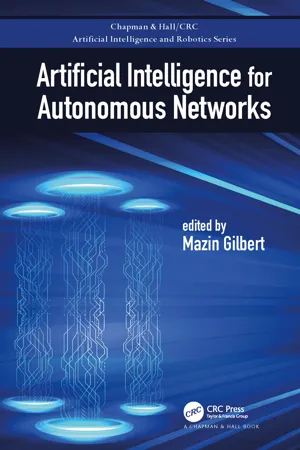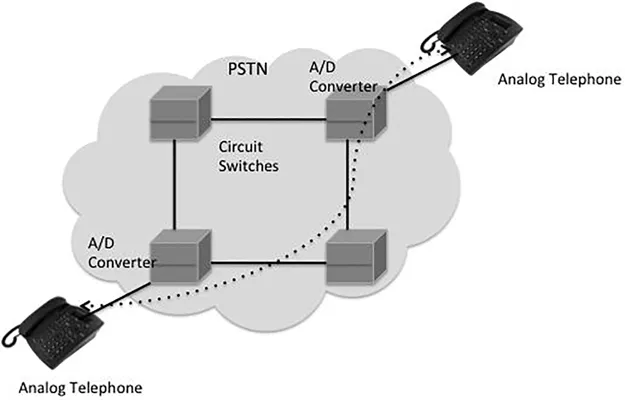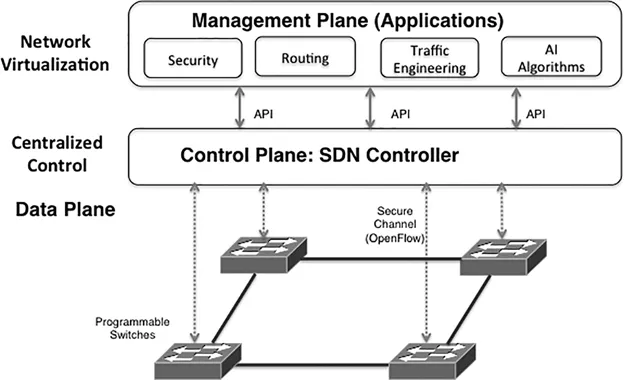![]()
CHAPTER 1
The Role of Artificial Intelligence for Network Automation and Security
Mazin Gilbert
CONTENTS
1.1 Introduction
1.2 Three Generations of Network Transformation
1.2.1 Back to Basics—The Communication Network
1.2.2 From Legacy to New
1.2.3 Software Eats the World
1.2.4 Intelligence Sits in the Cloud
1.2.5 The CapEx and OpEx Story
1.2.6 Are We Secure Yet?
1.3 From Automation to Artificial Intelligence
1.3.1 Framework for Artificial Intelligence
1.3.2 Artificial Intelligence Revisited
1.3.3 The Perfect Marriage Between Software-Defined Network and Artificial Intelligence
1.3.4 Journey Toward a Software-Defined Autonomous Network
1.3.5 Principles of Zero and One
1.4 Autonomous Networks Run on Data
1.4.1 Data Is the New Currency
1.4.2 Microservices Are Data Powered
1.4.3 Compute Follows You
1.4.4 Closing the Artificial Intelligence Loops
1.5 It Is a Whole New World
1.5.1 Operating a Virtual City
1.5.2 From Internet of Things to Internet of Everything
1.5.3 Your Service in a Heartbeat
1.5.4 Flying Cell on Wings to the Rescue
1.5.5 How May I Serve You?
References
1.1 INTRODUCTION
This chapter is an introduction to the technologies, opportunities, and challenges of the autonomous network—a product of integrating artificial intelligence (AI) with software-defined network (SDN). It provides an overview of the importance of automation for driving personalization, intelligence, and elasticity in the network. These characteristics drive operational efficiency, improved security, and enable scalability of a new spectrum of ultra-low latency services for supporting Internet of Things (IoT), autonomous cars, virtual reality (VR), and augmented reality (AR).
Section 1.2 presents an overview of the network transformation from proprietary vendor-locked networks to open SDNs running in the cloud, and soon, to autonomous networks adopting AI. Section 1.3 introduces the role of AI for driving an elastic, self-healing, and secure network. Section 1.4 explains the importance of data that fuels the autonomous network. Section 1.5 describes a new world of applications that will be enabled by the autonomous network.
1.2 THREE GENERATIONS OF NETWORK TRANSFORMATION
1.2.1 Back to Basics—The Communication Network
Although early evidence of communication was observed in Africa, the Americas, and China through the use of smoke signals and drums, the real breakthrough happened in the nineteenth century through the invention of the electric telegraph by Francis Ronalds [1]. The telegraph was the first communication network of its kind that enabled short-distance transmission of signals. In 1837, Samuel Morse, along with his assistant Alfred Vail [2], invented the Morse code for transmission of information across an electric telegraph. The telegraph used a transmitter, in the form of a sending device or encoder, which enabled sending a series of dots and dashes to represent letters and characters. At the receiving end, a decoder was used to receive the information that was then interpreted by an operator.
A communication network is essentially an interconnected system that facilitates the exchange of information. Behind this communication network, there are several basic technology components. An information source generates a signal, or message, that is then sent to a transmitter. This signal can be video, voice, or text, and is generated through devices, such as a camera, telephone, or keyboard. A transmitter processes this signal by performing amplification and modulation,1 and then generates an output that is suitable for transmission. The signal in early communication networks is transmitted in an analogue form. Thanks to Claude Shannon [3] and his theory of information, most signals today are converted into a digital form—binary digits of ones and zeros. The encoded signal can be transmitted either through a wireline channel, such as cable wires or fiber optics, or a wireless channel, such as Wi-Fi, BlueTooth, 4GLTE, or 5G. Wireless channels involve transmitting electromagnetic waves from one antenna to another (Figure 1.1).
FIGURE 1.1 Basic communication network. (From Shannon, C.E., A Mathematical Theory of Communication, Bell Systems Technical Journal, 1948.)
Maintaining a high-quality signal through the transmission channel is vital for effective communication. Quality is normally impacted through interference or noise. Noise can be environmental, industrial, or electronic and attributed to digitization or circuitry. Proper encoding of the signal and selection of the channel can help to maximize the signal-to-noise ratio as was shown by Shannon [3]. At the receiving end, the signal is demodulated and converted into a form that is suitable for the receiving device, which may be a speaker or a phone.
Modern communication networks are based on the invention of the telephone in 1876 by Alexander Graham Bell and Thomas Watson [4]. A telephone is used at the transmitter and receiver ends, with a centralized switchboard connected to each telephone. This invention gave birth to the Public Switch Telephone Network (PSTN) [5].
1.2.2 From Legacy to New
The telecommunication network, as envisioned by Alexander Bell, was essentially a form of a telegraph with voice on both ends. The network included transmitting electrical currents over electric wires duplicating sound waves. The invention of circuit switching was an improvement to Bell’s invention, allowing voice in analogue form to travel over longer distances. The circuit-switching network (Figure 1.2) includes switching nodes that facilitate the transmission of voice from the sender to the receiver. Additional switching nodes are typically developed to improve reliability of the network.
Although circuit-switching networks were suitable for voice communication, they presented several challenges. The first is inefficiency in the system for voice transmission. A voice call requires a dedicated channel capacity for the entire call. The capacity is wasted even when not in use. Establishing a call through the switching nodes also required long delays [6].
FIGURE 1.2 PSTN with circuit switches.
In the early 1970s, the PSTN began to transform toward packet-switched networks. Typically, messages are divided into a series of smaller packets plus control information, and then routed to its desired destination. In this design, packets can be queued and transmitted as fast as possible based on priorities. Node-to-node connections can be dynamically shared, hence allowing for data to be transmitted even during heavy traffic.
Managing, monitoring, and operating a communication network is a very complex and expensive undertaking. Network functions, such as routers, switches, and firewalls, include both specialized hardware and software that are vulnerable to failures and security attacks. Changes or replacements of this equipment require manual work in specified locations. Nevertheless, with the linear and predictable growth in traffic up to the mid-2000s, operators were complacent in operating and maintaining these hardware-centric networks.
In 2007, the communication network experienced a big bang with the birth of the iPhone and smart devices. Suddenly, traffic started to shift from essentially voice and some data, to mostly video data. Between 2007 and 2016, the AT&T network experienced 250,000% increase in traffic. This exponential increase in the demand is expected to continue that way for the next 10 years, imposing a significant burden on communication networks and requiring substantial investments in capital.
The Internet Protocol (IP)-based PSTN with packet processing and with “legacy” hardware-centric network equipment can no longer support the exponential growth in traffic. With market pressure to provide unlimited plans to consumers, it has become clear that the legacy approach is not sustainable, and operators need to employ new generations of technologies that provide flexibility, elasticity, and automation when managing network functions. Moving to a SDN and network function virtualization (NFV) is necessary to manage the rising operation costs and support the exponential traffic growth [7].
1.2.3 Software Eats the World
In 2011, Marc Andreessen wrote his famous “Why Software Is Eating the World” essay in The Wall Street Journal. Software and virtualization may not be new to the web companies, including Amazon, Google, and Microsoft, but it is a new way of thinking for networking and communication companies. Since the article was published, operators have been reimagining their network as a SDN to better manage the increase of their operational and services cost.
The key premise behind SDN is to separate the control, or management, plane of the network, which makes decisions on how packets flow, from the data, or forwarding plane, which move the packets from one node to the other. This design enables programming of data planes, virtualization of network functions, and leveraging commodity off-the-shelf servers. It also enables decoupling of the hardware switches from the software controllers through a southbound interface, or a protocol, such as OpenFlow [8].
As opposed to traditional legacy networks, which use specialized vendor-centric equipment such as firewalls and routers, SDNs allow applications to interface with the controller through a northbound protocol (Figure 1.3). In this design, an operator can integrate different network functions and employ different policies that may involve prioritizing, deprioritizing, or blocking specific packets flowing through certain switches. It also provides the operator the flexibility to run network workloads on a cloud computing multitenant architecture. This results in having more flexibility and elasticity to changing workloads through software while using less expensive commodity switches [7].
1.2.4 Intelligence Sits in the Cloud
Cloud computing is one of the most remarkable breakthroughs of the twenty-first century. The basic concept is to be able to run workloads and access and store data over the Internet instead of a local computer. The key advantage is gaining agility by being able to get on-demand access to compute, storage, and networking to workloads without making major capital investments. Public clouds, such as Amazon and Microsoft, provide a variety of different compute resources [9].
FIGURE 1.3 Basic SDN architecture.
FIGURE 1.4 Cloud model.
Public clouds typically offer three types of cloud businesses. Software-as-a-Service (SaaS), where a business subscribes to an application over the Internet. Platform-as-a-Service (PaaS), where a business develops its own custom applications that are shared. Infrastructure-as-a-Service (IaaS), where businesses “rent out” compute and storage on a pay-per-use model. Netflix, for example, provides services by renting IaaS from Amazon.
Virtualization is the underpinning behind the majority of high-performance clouds. It allows decoupling of the physical hardware from the compute operating system. In another word, it hides the compute resources from their users. Hence, a single physical resource, such as a server, can appear to function as multiple virtual resources. A hypervisor is the software layer that sits between the physical hardware and the operating system (Figure 1.4). It provides an interface to share the available resources through virtual machines, or VMs. A VM behaves as if it is running on an individual physical machine.
All businesses are moving toward cloud compute and virtualization to reduce operational and capital costs, while enjoying agility and elasticity for compute and storage. Thi...




